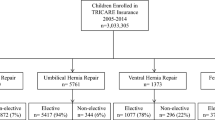Abstract
Purpose
This study uses a national database to evaluate the incidence of inguinal hernia and associated risk factors of incarcerated hernia in children from birth to 15 years of age.
Methods
The study selected children born from 1997 to 2005 from a randomly selected cohort of 1,000,000 from an insured population of 23 million. We regarded children that were classified with code 550 and hernia surgery in accordance to the International Classification of Diseases, 9th Revision, as having inguinal hernia. We used the 2 chi-square test and logistic regression modeling for statistical analyses.
Results
In total, 79,794 children (41,767 male and 38,027 female) were enrolled in the study. The cumulative incidence of inguinal hernia in males and females from birth to 15 years old were 6.62 and 0.74 %, respectively (p < 0.01). The peak incidence of inguinal hernia was at 0 years of age for males and 5 years of age for females. The ratio of unilateral vs. bilateral repair was 5.54:1. Females tend to have more bilateral inguinal hernia than males (25.4 vs. 12.9 %, p < 0.01). Incarcerated hernia occurred in 4.19 % children with inguinal hernia without significant gender discrepancy. Approximately 40 % of incarcerated hernia underwent hernia repair immediately after visiting the emergent department. In patients who presented with reducible hernia, we did not find significant correlation between waiting time to hernia repair and occurrence of incarceration.
Conclusions
The cumulative incidence of inguinal hernia from birth to 15 years of age was 6.62 and 0.74 % in males and females, respectively. Incarceration was not related to prematurity or the waiting time for surgery.

Similar content being viewed by others
References
Lao OB, Fitzgibbons RJ Jr, Cusick RA (2012) Pediatric inguinal hernias, hydroceles, and undescended testicles. Surg Clin North Am 92(3):487–504
Puri P, Guiney EJ, O’Donnell B (1984) Inguinal hernia in infants: the fate of the testis following incarceration. J Pediatr Surg 19(1):44–46
van Heurn LW, Pakarinen MP, Wester T (2014) Contemporary management of abdominal surgical emergencies in infants and children. Br J Surg 101(1):e24–e33
Rescorla FJ, Grosfeld JL (1984) Inguinal hernia repair in the perinatal period and early infancy: clinical considerations. J Pediatr Surg 19(6):832–837
Harper RG, Garcia A, Sia C (1975) Inguinal hernia: a common problem of premature infants weighing 1,000 g or less at birth. Pediatrics 56(1):112–115
Zamakhshary M et al (2008) Risk of incarceration of inguinal hernia among infants and young children awaiting elective surgery. CMAJ 179(10):1001–1005
Misra D (2001) Inguinal hernias in premature babies: wait or operate? Acta Paediatr 90(4):370–371
Pan ML et al (2013) A longitudinal cohort study of incidence rates of inguinal hernia repair in 0- to 6-year-old children. J Pediatr Surg 48(11):2327–2331
Antonoff MB et al (2005) American Academy of Pediatrics Section on Surgery hernia survey revisited. J Pediatr Surg 40(6):1009–1014
Gawad N, Davies DA, Langer JC (2014) Determinants of wait time for infant inguinal hernia repair in a Canadian children’s hospital. J Pediatr Surg 49(5):766–769
Gholoum S et al (2010) Incarceration rates in pediatric inguinal hernia: do not trust the coding. J Pediatr Surg 45(5):1007–1011
Timmers L, Hamming JF, Oostvogel HJ (2005) Non-incarcerated inguinal hernia in children: operation within 7 days not necessary. Ned Tijdschr Geneeskd 149(5):247–250
Gahukamble DB, Khamage AS (1996) Early versus delayed repair of reduced incarcerated inguinal hernias in the pediatric population. J Pediatr Surg 31(9):1218–1220
Erdogan D et al (2013) Analysis of 3,776 pediatric inguinal hernia and hydrocele cases in a tertiary center. J Pediatr Surg 48(8):1767–1772
Acknowledgments
The study is funded by Taipei Tzu Chi Hospital, Buddhist Tzu Chi Medical Foundation, TCRD-TPE-103-RT-6
Author information
Authors and Affiliations
Corresponding author
Ethics declarations
Conflict of interest
All the authors declare that they have no conflict of interest.
Rights and permissions
About this article
Cite this article
Chang, SJ., Chen, J.YC., Hsu, CK. et al. The incidence of inguinal hernia and associated risk factors of incarceration in pediatric inguinal hernia: a nation-wide longitudinal population-based study. Hernia 20, 559–563 (2016). https://doi.org/10.1007/s10029-015-1450-x
Received:
Accepted:
Published:
Issue Date:
DOI: https://doi.org/10.1007/s10029-015-1450-x




